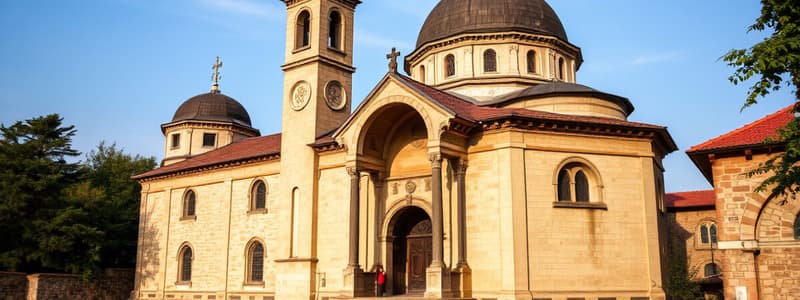Podcast
Questions and Answers
What is monasticism primarily characterized by?
What is monasticism primarily characterized by?
- Traveling extensively to spread religious beliefs
- Engaging in material pursuits and luxuries
- Living in isolation without a community
- A group of people living according to spiritual beliefs (correct)
What role did monasteries play in medieval Europe after the fall of the Roman Empire?
What role did monasteries play in medieval Europe after the fall of the Roman Empire?
- They evolved into educational institutions (correct)
- They were primarily military outposts
- They became centers of trade and commerce
- They served as safe havens for the wealthy elite
What was one reason men joined monasteries during the rise of monasticism?
What was one reason men joined monasteries during the rise of monasticism?
- For spiritual reasons and education (correct)
- To engage in trade
- To acquire wealth and land
- To gain political power
Who were the women involved in monastic communities called?
Who were the women involved in monastic communities called?
What did the rules governing monastic life typically address?
What did the rules governing monastic life typically address?
Which of the following groups settled in the territories of the former Western Roman Empire?
Which of the following groups settled in the territories of the former Western Roman Empire?
What was Charlemagne known for besides being a king?
What was Charlemagne known for besides being a king?
Which of the following best describes the lifestyle of monks in monasteries?
Which of the following best describes the lifestyle of monks in monasteries?
What was one of the impacts of monastic communities on rural areas during the rise of monasticism?
What was one of the impacts of monastic communities on rural areas during the rise of monasticism?
How did communal life benefit members of monastic communities?
How did communal life benefit members of monastic communities?
What was Charlemagne's approach to power?
What was Charlemagne's approach to power?
How did Charlemagne contribute to the spread of knowledge?
How did Charlemagne contribute to the spread of knowledge?
What new form of writing did Charlemagne encourage?
What new form of writing did Charlemagne encourage?
What significant event happened in the year 800 CE for Charlemagne?
What significant event happened in the year 800 CE for Charlemagne?
What was Charlemagne's military strategy?
What was Charlemagne's military strategy?
What role did the Church play during Charlemagne's reign?
What role did the Church play during Charlemagne's reign?
Who succeeded Charlemagne after his death in 814 CE?
Who succeeded Charlemagne after his death in 814 CE?
What happened to Charlemagne's empire after his death?
What happened to Charlemagne's empire after his death?
What literary artifacts were produced due to Charlemagne's encouragement?
What literary artifacts were produced due to Charlemagne's encouragement?
What was the primary religious affiliation established in Charlemagne's empire?
What was the primary religious affiliation established in Charlemagne's empire?
Study Notes
Rise of Monasticism
- Christianity predominantly practiced in European cities during the sixth and seventh centuries CE; rural areas had varying religious beliefs.
- The rise of monasticism in the seventh and eighth centuries led to a unification of religious practices.
- Monasticism involves communities living together according to spiritual beliefs, characterized by simplicity, prayer, and detachment from material goods.
- Men living in monasteries are known as monks, while separate groups of women, known as nuns, formed later.
- Monks sought spiritual fulfillment, education, and community safety, thriving through shared labor and possessions.
- Monasteries became crucial centers of learning due to the scarcity of schools and the absence of universities in Europe.
- Common operational rules for monasteries outlined daily life, including clothing and dietary restrictions, enhancing stability after the fall of the Roman Empire.
The Reign of Charlemagne
- Following the Western Roman Empire's fall, groups like the Franks migrated to its former territories and established new cultures.
- The Franks, particularly near the Rhine River in Cologne (Germany), grew strong by the eighth century CE, with Charlemagne (Charles the Great) rising as a prominent king.
- Charlemagne excelled in organizing and managing people, effectively inspiring and mobilizing armies without reliable maps.
- His leadership emphasized not just personal power but the spread of Christianity and the promotion of learning.
- Although Charlemagne was illiterate, he brought European scholars to his kingdom to copy important texts, facilitating the growth of monastic libraries.
- He encouraged a clear and readable script, leading to the creation of illuminated manuscripts embellished with colorful decorations, including gold and silver.
- Charlemagne's military strategies ensured his army's superiority in numbers and supplies, expanding his kingdom across much of western Europe.
- In 800 CE, Pope Leo III crowned Charlemagne emperor of the Holy Roman Empire, restoring some stability to the region.
- This crowning reinforced the Church's role, making Christianity the prominent religion and embedding it in daily life, with regular attendance at local churches.
- Clergy became significant educational providers and wielded substantial socio-political influence during this era.
- Charlemagne's reign bolstered the intellectual, political, and military frameworks of western Europe, ushering in a new period of unity and strength despite not achieving Roman organizational levels.
- Upon Charlemagne's death in 814 CE, his son Louis took power, but the empire was eventually divided among his grandsons, leading to the formation of France and Germany.
Studying That Suits You
Use AI to generate personalized quizzes and flashcards to suit your learning preferences.
Description
Explore the emergence and impact of monasticism in Christianity during the sixth and seventh centuries CE. This quiz covers the transition from varied rural beliefs to the establishment of monastic communities that shaped religious practices. Test your knowledge on how monasticism influenced the spread of Christianity in Europe.




